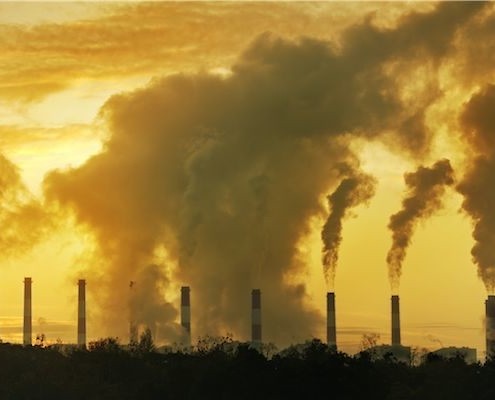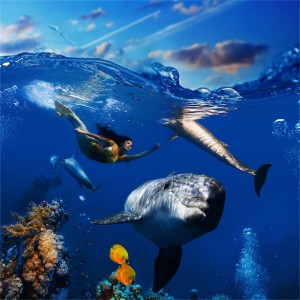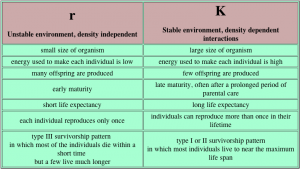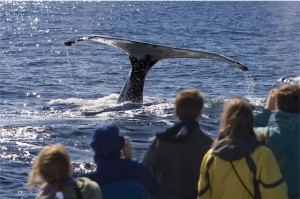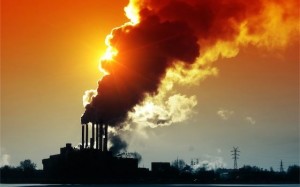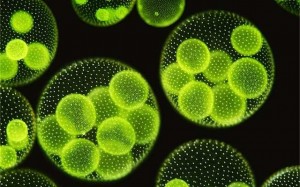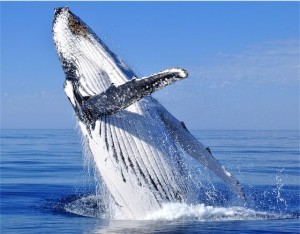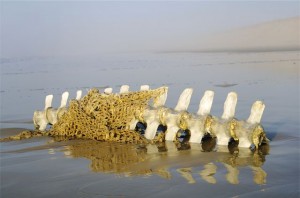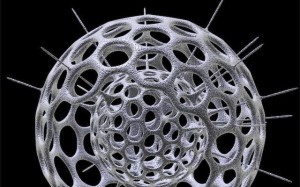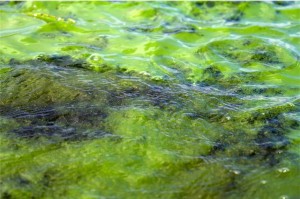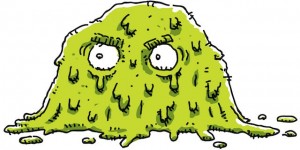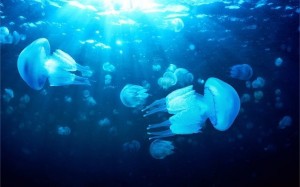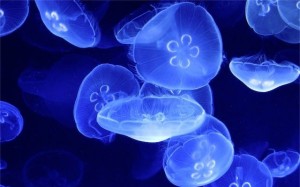Food Webs and the Future – Say Goodbye to ocean species with brains
Whales, Dolphins, Seals, Fish, Seabirds, and thousands of other species cannot be expected to survive rapidly-acidifying seas.
We can put a face on Ocean Acidification.
It’s the face of dolphins, whales, seals, fish, seabirds and other species which cannot be expected to survive acidification.
This may be the first time you’ve heard that ocean acidification will doom most large, high-metabolism sea creatures. But you’d better believe it. It’s what the science says, even though you have to understand a few simple concepts to get it.
The reasons in any given case are varied and complex, but they boil down to some simple general rules.
Poodles, cockroaches, grass and bacteria.
For example, say you have a hypothetical island populated by poodles, cockroaches, and bacteria.
You then subject this odd ecosystem to abrupt stresses. It can be pretty much any kind of stresses. Drought, heat, plague, nuclear detonation, toxic waste, let your imagination run wild.
What you’ll find, in this mental exercise, is that the bacteria survive about everything. The grass and cockroaches survive quite a bit. And the poodles can’t deal with much change at all.
Change and Stability
Species tend to lie on a continuum between those which are adapted to stable environments and those which can adapt to changing environments. The heavily adapted species in stable environments are termed K-type species, while the adaptable species which thrive on change are called r-type.
K-type species are like us. They have only a few large offspring that take a long time to mature. They tend to live a long time. They’re large. Most live to near their maximum lifespan.
r-type species are more like the cockroaches, or even the bacteria. They’re small. Most die young. They have huge numbers of offspring which mature quickly. And by reproducing fast, they are more able to change their phenotype, and to have a chance of evolving to deal with changes.
The oceans of earth have, to the best of scientists’ knowledge, never acidified at anything like this rate before. Even the worst previous acidfication events, deep in the the primordial past, were on the order of ten times slower.
Life on earth has never had to deal with this before. And it’s damn sure that whales, dolphins, and top ocean predators have never had to deal with it before. In addition to being extreme examples of K-type species, many of them are high on complex food chains, dependent on stability of food webs from primary plankton all the way up to the food they eat.
If we burn fossil carbon at current rates this century, the productive plankton organisms will in large part go away. They tend to need calcium carbonate skeletons to exist, and the calcium carbonate will all fizz away and be gone for millions of years, until the geologic process of silicate weathering gradually raises the pH.
But when that happens, the current K-type species will exist only as fossils.
And not just plankton. Krill – the food of many whales – will be affected. They will tend to be replaced by jellies and salps, low-nutrient-density animals that would starve high-energy marine predators.
Worse, the coral reefs will go away. A very large percentage of the ocean’s fish biomass, including migratory pelagic fish, use coral reefs to shelter their young. As things now stand, coral reefs will all be dead by the time a child born today reaches menopause.
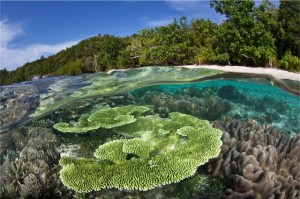

This just begins to describe the food web chaos. Many animals in the food web use calcium carbonate for their shells and internal skeletons. They have already started to dissolve, in the arctic and antarctic. Soon – if we keep burning carbon – they will all dissolve, and the last generations of young will be unable to create skeletons.
What we’re talking about is nothing less than an ocean apocalypse. While humans worry about the sea level rising a foot or two to flood their basements in the coming hundred years, very few realize that the seas of earth will – by reasonable human criteria – be dead in the same time from acidification.
Mass extinctions are a chaotic event, and they play out in complex ways, but we can know some things.
Species like whales, dolphins, seals, swordfish, tuna, and other large carnivores are like an ecological house of cards. By their nature, they are stable-ecosystem creatures well adapted to the foods they need to survive. They have very slow reproductive rates. They need to live a long time to reproduce. They need high-energy, high-nutrient-density foods. They need ecosystems of cold water and high oxygen.
All of that will be going away. It’s already happening, with increasing areas of “dead zones” and bacterial overgrowth.
What species will replace these animals? Bacteria, algae, jellyfish, worms. The same creatures which have evolved for changing, warm, low-oxygen seas in the earth’s past, and have existed at the fringes since that time. In our frenzy of burning buried carbon from ancient seas, we are bringing back those ancient seas of slime, jelly, and toxic gasses.
If this doesn’t scare you sh*tless, you’re not paying attention.
We need to bring human burning of fossil carbon to a screeching halt, or lose the world we evolved in. It won’t happen in future centuries. These changes will be a “done deal” during the lifetimes of humans now in high school.
The punchline is that as bad as climate change may be – and that might be very bad indeed – that ocean acidification is WORSE and it is HAPPENING FASTER.
That’s what the FutureSeas campaign is about.
Nothing less than changing the energy basis of human civilization, to keep from losing a world.
Fight the Slime!
This is the biggest, most important fight humans have ever needed to fight. It’s a bigger deal than Hitler, than the black plague, the great depression, than any human issue in history. It’s the fight to keep our evolved planetary life systems from dying.
Our oceans will quickly revert to anoxic, slimy bacterial seas. The bacteria which produce methane and hyrdogen sulfide are already waiting. The jellyfish are blooming. The algal sludge of eutofication is growing. The oceans are warming and acidifying, and the calcium carbonate is starting to dissolve. And if things keeping going the way they are, that’s the way it will be.
But we belong to a species which calls itself Homo Sapiens, “wise man”. Unlike the brainless life of primordial seas, we have brains and some ability to reason. While we are mostly controlled by short-term pursuit of pleasure, gratification and safety, we are capable – in principle – of making hard choices. Of sacrificing for a good cause. Of putting the interests of our children ahead of our own.
And that’s the question, isn’t it.
Whether we will, ourselves, act like yeast in a bottle, partying until our wastes smother us, or will put a full stop on our destructive ways to save our world and our future.
One of our staffmembers came up with “Fight the Slime!” as a good slogan, and we’re running with it. Humans really do better at fighting a good fight when they can put a face on an enemy. (Things like scientific data don’t engage our core brains. What happens in the neocortex stays in the neocortex).
It’s time to choose a side. Each of us needs to decide whether we’re on the side of complex evolved ecosystems, or on the side of the slime.
Currently, we’re now the de facto allies of the slime. When we run our cars, air condition our homes, go shopping, etc, all that is powered, in most places on earth, by burning the carbon from ancient seas and forests. Carbon that took hundreds of millions of years to safely sequester away from the biosphere, set free again to heat the planet and acidify the seas.
Make no mistake, we won’t save the seas without radical change.
If you care about this, you need to start doing things that will seem pretty radical, too. You need to step up and help figure out how to end the burning of fossil carbon within your lifetime. You can join us, or strike out on your own, but you’d better get busy. Look around… nobody else is succeeding.
Fight the slime.
It’s a fight we can’t afford to lose.
The Rise of Jellyfish
Like the classic game Rock, Paper, Scissors, each of the perturbations vexing our oceans can be argued to overarch the others. But the reality is, they are severally and collectively part of an integrated system that both feeds and is fed, supplies and demands, gives and takes as part of the cycles of nature. Carbon dioxide in the air leads to warming and acidification . . . Acidification leads to flagellates and jellyfish . . . Warming leads to stratification, which leads to hypoxia . . . Hypoxia changes the water chemistry, which leads to flagellate blooms, which lead to jellyfish . . . Warming also enhances plant and animal growth, which leads to blooms, which lead to hypoxia . . . Warming also reduces oxygen in the water, making respiration more difficult, which leads to jellyfish . . . Overnutrification leads to flagellates . . . Pollution leads to flagellates . . . Flagellates lead to jellyfish. Rock, paper, scissors.
It appears that, in many cases, jellyfish blooms are merely the most visible part of distressed ecosystems. In many cases, jellyfish are a symptom rather than a cause. As phytoplankton shift, so do copepods, and as smaller copepods dominate, fish decline. Perhaps in some cases jellyfish move into a vacant niche space, whereas in other cases, jellyfish are the last man left standing in an ecosystem where higher-energy animals can no longer thrive, while in still other cases, the ecosystem shifts to give jellyfish the competitive advantage. Anyway, jellyfish flourish.
As ecosystems shift away from diatoms toward flagellates, we can expect increasing frequency and duration of jellyfish blooms, along with decreasing population abundance of species on the high energy food chain.
Regions like the Bering Sea, the Gulf of Mexico, the North Sea, the Gulf of Maine, and Antarctica have traditionally provided a large fraction of the marine resources, such as finfish and shellfish, that feed the world. These too can be expected to further decline.
It probably won’t happen slowly, where we can watch for signals and milestones to decide when “enough” has occurred and it’s time to take action. Those signals and milestones have been all around us for decades and we have chosen to ignore them. It will probably happen more like a house of cards, where one card falls, causing others to fall, and so on. Pressure from above, unstable foundation below. We have, over the decades and through wanton disregard for consequence, turned our ecosystems into neighborhoods of card houses. So many populations of so many species are hanging on in dwindling numbers that it is hard to imagine that they will be resilient enough to endure a reshuffling of the food chain. And as one species collapses, so will those above it.
– Dr. Lisa-Ann Gershwin, author of Stung!


